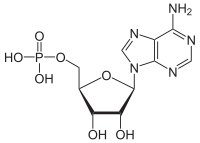
Photo from wikipedia
EPA, an omega-3 polyunsaturated fatty acid, exerts beneficial effects on human health. However, the molecular mechanisms underlying EPA function are poorly understood. The object was to illuminate molecular mechanism underlying… Click to show full abstract
EPA, an omega-3 polyunsaturated fatty acid, exerts beneficial effects on human health. However, the molecular mechanisms underlying EPA function are poorly understood. The object was to illuminate molecular mechanism underlying EPA’s role. Here, 1H-NMR-based metabolic analysis showed enhanced branched-chain amino acids (BCAAs) and lactate following EPA treatment in skeletal muscle cells. EPA regulated mitochondrial oxygen consumption rate. Furthermore, EPA induced calcium/calmodulin-dependent protein kinase kinase (CaMKK) through the generation of intracellular calcium. This induced the phosphorylation of AMP-activated protein kinase (AMPK) and p38 mitogen-activated protein kinase (p38 MAPK) that led to glucose uptake, and the translocation of glucose transporter type 4 (GLUT4) in muscles. In conclusion, EPA exerts benign effects on glucose through the activation of AMPK-p38 MAPK signaling pathways in skeletal muscles.
Journal Title: International Journal of Molecular Sciences
Year Published: 2019
Link to full text (if available)
Share on Social Media: Sign Up to like & get
recommendations!